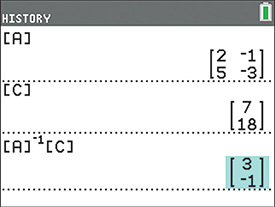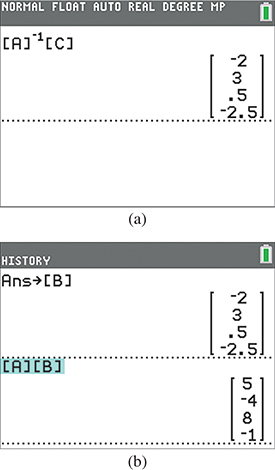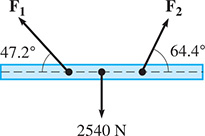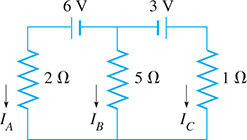16.4 Matrices and Linear Equations
Multiply Matrix of Constants by Inverse of Matrix of Coefficients • Solving Systems of Equations • Matrix Solution on a Calculator
As we stated at the beginning of Section 16.1, matrices can be used to solve systems of equations. In this section, we show one method by which this is done. As we develop this method, it will be apparent that there is a great deal of numerical work involved. However, methods such as this one are easily programmed for use on a computer, which can do the arithmetic work very rapidly. Also, most calculators can perform these operations, and we will show an example at the end of the section in which a calculator is used to solve a system of four equations more readily than with earlier methods. It is the method of solving the system of equations that is of primary importance here.
Let us consider the system of equations
Recalling the definition of equality of matrices, we can write this system as
If we let
the left side of Eq. (16.6) can be written as the product of matrices A and X.
If we now multiply (on the left) each side of this matrix equation by we have
Because we have
However, Therefore,
NOTE
[Equation (16.9) states that we can solve a system of linear equations by multiplying the one-column matrix of the constants on the right by the inverse of the matrix of the coefficients.]
The result is a one-column matrix whose elements are the required values for the solution.
CAUTION
Note that and not The order of matrix multiplication must be carefully followed.
EXAMPLE 1 Matrix solution—two equations
Use matrices to solve the system of equations
The matrices for Eq. (16.7), and the matrix equation are
By either of the methods of the previous section, we can determine the inverse of matrix A to be
We now form the matrix product
Because this means that
Therefore, the required solution is and which checks when these values are substituted into the original equations. See the calculator matrix solution shown in Fig. 16.11.

Fig. 16.11
Graphing calculator keystrokes: bit.ly/
EXAMPLE 2 Matrix solution two equations—electric current
For the electric circuit shown in Fig. 16.12, the equations used to find the currents (in amperes) and are

Fig. 16.12
Using matrices to solve this system of equations, we set up the matrix A of coefficients, the matrix C of constants, and the matrix X of currents as
We now find the inverse of A as
Therefore,
Therefore, the required currents are and These values check when substituted into the original equations.
EXAMPLE 3 Matrix solution—three equations
Use matrices to solve the system of equations
Setting up matrices A, C, and X, we have
Finding (see Example 4 of Section 16.3) and solving for X, we have
Thix means that and
EXAMPLE 4 Matrix solution on a calculator—4 equations
Use a calculator to perform the necessary matrix operations in solving the following
First, we set up matrices A, X, and C:
It is now necessary only to enter matrices A and C in the calculator and find the matrix product as shown in Fig. 16.13(a). (There is no need to record or display ) This shows that the solution is

Fig. 16.13
Graphing calculator keystrokes: bit.ly/
This solution can be checked on the calculator by storing the resulting matrix X as matrix B and finding the matrix product AB, which should equal matrix C as shown in Fig. 16.13(b). The product AB is equivalent to substituting each value into the original equations, as shown in Eq. (16.8).
EXERCISES 16.4
In Exercises 1 and 2, make the given changes in the indicated examples of this section and then solve the systems of equations.
In Example 1, change the 18 to 19 and then solve the system of equations.
In Example 3, change the in the top equation to and then solve the system of equations.
In Exercises 3–8, solve the given systems of equations by using the inverse of the coefficient matrix. The numbers in parentheses refer to exercises from Section 16.3, where the inverses may be checked.
In Exercises 9–16. solve the given systems of equations by using the inverse of the coefficient matrix
In Exercises 17–28, solve the given systems of equations by using the inverse of the coefficient matrix. Use a calculator to perform the necessary matrix operations and display the results and the check. See Example 4.
In Exercises 29–40, solve the indicated systems of equations using the inverse of the coefficient matrix. In Exercises 35–40, it is necessary to set up the appropriate equations.
For the following system of equations, solve for and y using the matrix methods of this section, and then solve for x and y.
For the following system of equations, solve for and using the matrix methods of this scction, and then solve for x and y.
 Solve any pair of the system of equations and Show that the solution is valid for any pair chosen. What conclusions can be drawn about the graphs of the three equations?
Solve any pair of the system of equations and Show that the solution is valid for any pair chosen. What conclusions can be drawn about the graphs of the three equations? In solving the system of equations when conclusion can be drawn?
In solving the system of equations when conclusion can be drawn?Forces and hold up a beam that weights 2540 N, as shown in Fig. 16.14. The equations used to find the forces are

Fig. 16.14
Find the magnitude of each force.
In applying Kirchhoff’s laws to the circuit shown in Fig. 16.15, following equations are found. Determine the indicated currents (in A).

Fig. 16.15
Two batteries in an electric circuit have a combined voltage of 18 V, and one battery produces 6 V less than twice the other. What is the voltage of each?
For college expenses, a student took out a loan at 4.00%, and a semester later took out a second loan at 3.00%. The total annual interest for the two loans was $245. If the second loan had been for twice as much, the annual interest would have been $290. How much was each loan?
What volume of each of a 20% acid solution and a 50% acid solution should be combined to form 48 mL of a 25% solution?
Two computer programs together require 236 MB (megabytes) of memory. If one program requires 20.0 MB of memory more than twice the memory of the other, what are the memory requirements of each program?
A research chemist wants to make 10.0 L of gasoline containing 2.0% of a new experimental additive. Gasoline without additive and two mixtures of gasoline with additive, one with 5.0% and the other with 6.0%, are to be used. If four times as much gasoline without additive as the 5.0% mixture is to be used, how much of each is needed?
A river tour boat takes 5.0 h to cruise downstream and 7.0 h for the return upstream. If the river flows at 4.0 mi/h, how fast does the boat travel in still water, and how far downstream does the boat go before starting the return trip?
